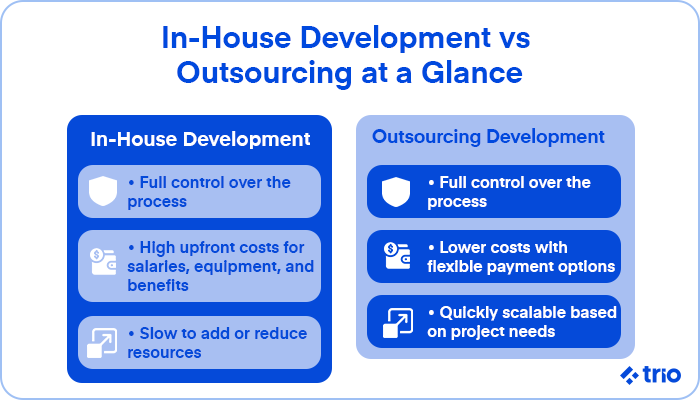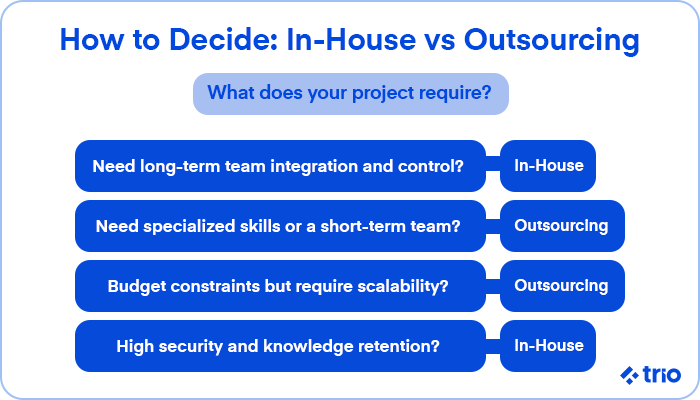When it comes to developing software for your business, deciding between in-house and outsourced development is one of the most critical choices you’ll make. It is one of the most common questions we address with our own clients here at Trio.
Both approaches offer unique advantages, and the right choice can depend on factors ranging from your budget to your long-term goals.
In short, the biggest difference between outsourcing vs in-house development is that the former requires less management, but also gives you less control. The latter may require more effort on your part but ensures you get what you want.
At Trio, we provide access to developers who are proficient in a variety of models. Whether you are building a web app or mobile app or looking at business automation, our thoroughly vetted developers can help you with your software development project.
But first, let’s help you understand the key differences, pros, and cons of each option to help you choose the best development strategy for your needs.

What is the Difference Between In-House Software Development vs Outsourcing?
Understanding In-House Software Development
In-house software development refers to assembling and managing a team of software developers within your organization.
This in-house software development team – working on-site or remotely – is employed exclusively by your company, providing a sense of continuity and cultural alignment as they create software that meets your specific needs.
As we have already mentioned above, typically, in-house development involves a greater level of direct control.
This means that a dedicated team is often best suited for companies with consistent software development needs, as well as those looking for close collaboration between developers and other departments.
With direct control over all aspects of development, your in-house team can maintain a deep understanding of your company’s processes and goals.
Defining Outsourcing in Software Development
Outsourcing software development involves delegating project responsibilities by contracting an external team of professionals, whether through a specialized agency or building a team of freelance individuals, to handle your project.
This can include offshoring (working with teams abroad), nearshoring (in neighboring countries), or onshoring (within your own country). We can help you with any of these options at Trio.
By walking you through what you can expect from each location, you can rest easy, knowing you have all the information required to choose an outsourcing country. And, by hiring through Trio, you are not obligated to traverse the legal field.
Outsourcing is particularly attractive if you are looking to tap into specialized skills, save on costs, or avoid the complexities of hiring full-time staff.
As outsourcing involves leveraging a global talent pool through dedicated outsourcing companies, outsourcing allows your business to quickly scale up resources to meet project demands.
You can do all of this without needing to commit to long-term employment or infrastructure.
Comparing In-House and Outsource Software Development
The main differences between in-house development vs outsourced development come down to factors like control, cost, scalability, security, and cultural alignment. Here’s a quick comparison:
| Factors | In House Development | Outsourcing Development |
| Control | Full control. | Limited control. |
| Cost | High costs for hiring and onboarding initially, as well as salaries and benefits going forward. | Lower costs and sometimes flexible payment structures. |
| Scalability | It takes time to add people to your team, and it is difficult to downsize if you need to. | It can be scaled up easily, but it is also difficult to scale down after the project has started. |
| Security | Greater control over data and IP | May need NDAs and additional protocols to ensure security. |
| Cultural Fit | Can match new hires to full cultural alignment. | There may be massive differences, especially resulting from location. |
What Are the Pros and Cons of In-House Product Development?
Advantages of Having an In-House Development Team
There are several advantages that you can consider when thinking about hiring in-house developers: control, flexibility, cultural alignment, knowledge retention, communication, and collaboration.
With an in-house team, you have complete oversight and control over the development process.
This means you can make real-time changes, prioritize features, and respond quickly to feedback or issues as they arise.
Having control over the entire development process allows you to adapt the project as needed, ensuring that the software meets your evolving business needs and standards.
Employees within your organization will also have a strong understanding of the company’s values and mission. There are many reasons for this understanding, but it is largely a result of the amount of time spent in your company.
This understanding and alignment are also something that we ensure here at Trio, regardless of the hiring model you go with, as they create a sense of purpose and ensure developer satisfaction and performance.
This alignment can translate to a sense of ownership and dedication, which helps the team produce work that truly reflects your company’s vision. This can also help speed up the development process.
Another effect of the amount of time spent with your company is that in-house teams develop an understanding of your systems, culture, and customers.
This knowledge helps them build, maintain, and iterate on software in ways that can be challenging for an outsourced team or software development company that hasn’t necessarily got that knowledge of the entire software system to replicate.
Finally, having everyone within the same team structure simplifies communication.
In-house developers can easily collaborate with other departments like marketing, customer support, or sales, making it easier to align development work with broader business objectives.
They also get to know one another, figuring out where each of their strengths and weaknesses lie and the unique nuances of how people communicate with one another.

Challenges Faced by In-House Teams
Unfortunately, there are some downsides to in-house developers.
In-house development may be more expensive.
Hiring, training, and retaining a skilled development team is costly. In addition to salaries, you’ll need to account for benefits, bonuses, office space, and equipment, including hardware and software essential for development.
You may also run into issues regarding resource constraints. Building and maintaining an in-house team from scratch requires finding the right talent, which can take time.
Small to medium-sized companies may struggle to attract top-tier talent if larger firms with more resources are competing for the same professionals.
A lot of our clients here at Trio have experienced this. They need developers urgently, but they just do not have the resources to find them, or they might not have the ability to onboard the talent quickly enough.
This is where we come in, helping you build trust in software partnerships for scalable app development, even with minimal resources on your part.
In a similar vein, an established in-house team might not be able to handle spikes in development demands. If a project suddenly requires more resources, adding new team members is a slower process than bringing in outsourced help.
And this new talent is costly to keep in the long term if this workload is not sustained.
How to Evaluate Your In-House Development Capabilities
To determine if your company can support an in-house team, consider factors like your long-term software needs, budget, and access to talent.
If software and app development is a core part of your business, building an in-house team can be worth the investment. However, if your projects are sporadic, you may want to think twice before committing to this model.
What Are the Advantages of Outsourcing Software Developers?
Benefits of Hiring an Outsourcing Partner
If you decide to hire an outsourced software development team, you will be able to take advantage of several benefits.
Possibly, the greatest benefit is that outsourcing provides access to specialized skills.
As we have mentioned above, outsourcing allows you to tap into a global talent pool, enabling you to find experts in specific technologies or industry sectors. This can be especially valuable for niche projects that require specialized skills.
And, as if that were not enough, you also benefit from flexibility and scalability.
With an outsourcing model, it’s easy to scale your team up or down based on project demands, especially if you partner with a company like Trio, which has a host of developers on hand, thanks to our focus on retaining top developer talent.
Outsourcing providers can quickly make adjustments thanks to their access to various developers.
This means that whether you need extra resources for a large project or want to streamline after initial product development and launch, outsourcing gives you the flexibility to adjust without long-term commitments.
Finally, there is the reduced management overhead.
Many outsourcing providers handle team management, meaning you can focus on the bigger picture while the provider handles the day-to-day details and development tasks.
This hands-off approach means outsourcing can free up valuable time and resources for your internal team. It is also very useful if you don’t have the required technical knowledge to manage individual aspects of the project on your own.
Cost Efficiency in Outsourcing Development
Outsourcing can offer cost savings, as you’re only paying for the services when you need them.
By avoiding the expenses tied to full-time employment, which we have mentioned as one of the major downsides of hiring an in-house team, outsourcing can be a more economical option, particularly for startups and smaller businesses.
Additionally, the outsourcing market provides options to pay per hour, per development project, or through other flexible billing structures.
You could still make use of this through other models like staff augmentation, but it is not so easy with a full-time, in-house hire.
Accessing a Wider Talent Pool with Outsourced Development
When you outsource, your talent options aren’t limited by geography.
Outsourced development allows you to find highly skilled developers from around the world, often at lower costs, depending on the location.
This diversity of experience and perspective can be a significant asset, especially if you’re working on an innovative or complex project. Additionally, many countries have an incredible focus on STEM, producing highly skilled workers.
At Trio, we hire people from all over the world, including Africa, Latin America, and Eastern Europe, where the average salaries are lower, allowing you to minimize software development costs and take advantage of different skills.
When Should You Choose In-House vs Outsource Software Development?
Factors to Consider When Choosing Between In-House and Outsourcing
We’ve already touched on how you need to consider elements like budget, project complexity, and timeline.
Long-term, complex projects with strict security needs may benefit from an in-house team, while short-term or skill-specific projects often make more sense to outsource.
You should be considering your entire software development lifecycle as well. Will you need ongoing maintenance? If so, how can you ensure that this is done in the best way possible? If you are building an MVP, what about the additional features?
How to Assess Project Complexity and Resource Availability
The best way to assess project complexity is to speak to an experienced developer who will be able to advise you. However, if you do not have access to a developer, here are some things to consider.
First, what are the technical requirements? This can be things like particular expertise or even just the language and frameworks you decide to use.
Then, consider how many hours developers may have to work on the project to get it done and the timeline that you are looking at.
If you have an existing team, this is where you should realize if you have an issue or not. Do you have any skill gaps you need to fill? Or do you simply need more manpower to get the project done on time?
Finally, you need to think about your budget and compare the costs of in-house hiring and outsourcing.
Making the Decision: In-House Development Team or Outsource?
Ultimately, the best decision depends on your company’s goals and the nature of your project.
The decision between in-house software development and outsourcing should consider factors like budget, project complexity, and long-term needs.
For companies with the resources to support a full-time team and ongoing projects, in-house development can provide significant benefits. If you’re looking for agility, specific expertise, or a short-term engagement, outsourcing may be the right fit.

How to Build an Effective In-House Development Team?
Steps to Hire Software Developers for In-House Teams
When you decide to hire in-house, begin by clearly defining the specific skills and experience you need for your projects.
It’s important to articulate not only the technical requirements but also the qualities that will help a new hire integrate with your company culture and long-term goals.
A well-crafted job description can be your first step in attracting candidates who align with your mission and expectations.
Alternatively, you can set up a call with us here at Trio so that we can get a better understanding of your project and take care of the rest on your behalf.
The hiring process itself should go beyond a basic resume review.
Consider using technical challenges or coding assessments to gauge each candidate’s skills, and include interviews with different team members to ensure the applicant can work well within your team.
This collaborative approach to hiring can help identify individuals who are not only technically capable but also culturally willing to grow with your organization.
Offering competitive benefits and highlighting opportunities for professional development can make a significant difference in attracting top talent, especially since skilled developers often have multiple options.
To do this, you will need to research average salaries for the positions you are filling. This can be quite time-intensive. But Trio can take care of this for you to ensure the most cost-effective app development possible without compromising quality.
Creating a Collaborative Environment for Development
Once you’ve assembled your team, building a culture that promotes open communication and collaboration is essential across all development stages.
We’d recommend that you start by investing in the right tools: platforms like Slack and Microsoft Teams facilitate real-time communication. Many of these are free to use, so we always recommend them to startups and smaller companies.
At Trio, we can also vouch for the importance of project management software like Jira or Trello. We use software like this for our own company and have found that it helps everyone stay aligned on tasks and deadlines.
If some team members work remotely, regular virtual check-ins can also ensure they feel connected and supported.
It’s also very important that you encourage your developers to interact regularly with other departments, such as marketing or customer support so that their work aligns closely with broader business objectives.
When developers understand how their contributions impact other areas, it fosters a sense of ownership and accountability.
Additionally, creating a culture of transparency by holding regular retrospective meetings allows team members to share feedback and improve workflows collectively, which can lead to stronger team cohesion.
You don’t need to implement all of these strategies to build a collaborative development environment, but dipping into a few and expanding if needed may be highly effective.
Training and Development for In-House Employees
In a field like software engineering, where technology and best practices evolve quickly, continuous learning should be a priority.
Your developers need to set aside time and resources to engage in professional development activities, whether through courses, certifications, or even attending industry conferences.
We’ve seen how many companies offer “learning days” or sponsor courses to help their employees stay at the cutting edge of the industry, which also benefits your projects.
Creating an internal knowledge-sharing culture can further enhance your team’s expertise and morale.
For instance, hosting regular “lunch-and-learn” sessions, where team members can share recent discoveries or projects, fosters a culture of curiosity and collaboration.
Pairing junior developers with experienced mentors can accelerate learning and growth, giving your team a structure that supports skill transfer and provides senior developers with leadership opportunities.
Overall, the best way to ensure that your developers are growing is to ensure their well-being. This encourages them to stay passionate about their work and motivates them to take their training and development seriously.
What Should You Look for in an Outsourcing Partner?
Identifying Reliable Outsourcing Partners
To make sure that you choose a reputable outsourcing partner, start by researching outsourcing agencies with proven expertise in your field.
Reading client reviews, testimonials, and case studies can offer valuable insight into each provider’s track record and client satisfaction.
If you aren’t sure about a company, we’d recommend that you turn to platforms like Clutch or G2, which aggregate reviews and can provide objective feedback on the provider’s reliability.
Once you have a shortlist, you can request case studies or specific examples of similar projects they’ve handled in your industry.
Also, don’t hesitate to ask for references, as speaking with previous clients can help you understand the provider’s strengths and any areas where challenges may have arisen.
At Trio, we are happy to provide all of this, with the goal of setting up a long-term tech partnership where your success is our success.
Additionally, make sure to discuss the provider’s development methodologies, such as whether they follow Agile practices, to ensure their approach aligns with your project’s needs.
The important thing is to have as much information as you possibly can before you make a decision.
Evaluating the Expertise of Outsourced Development Teams
After you’ve established trust with a provider, you’ll want to assess the team’s technical skills to ensure the quality of the software meets your standards.
Conducting technical interviews or code assessments for key team members allows you to verify their proficiency before committing to a partnership.
As already mentioned, we do all of this at Trio. But, if you would like more control and want to do some of your own assessments, we can help you find appropriate interview questions.
If your project requires industry-specific knowledge, such as healthcare or finance, check that the team has experience with relevant regulations or standards, which can minimize the risk of errors and improve the efficiency of your collaboration.
You’ll also want someone on your team with experience navigating certain legal aspects. Some of the most common examples we’ve come across at Trio are those related to privacy, data management, and cybersecurity.
Also, how does the team problem-solve? A skilled outsourcing team should be proactive in addressing issues and have a clear escalation process for unexpected challenges.
Understanding how they tackle problems can help you feel confident about the quality of support they’ll provide throughout the project.
The only way you can really test this is to contact their references and ask about any issues that came up.
Understanding the importance of Communication with Outsourcing Teams
Clear, consistent communication is one of the cornerstones of a successful outsourcing relationship.
We always recommend that you define communication protocols at the beginning of your collaboration, covering areas like meeting frequency, project updates, and preferred communication channels.
This helps everyone feel like they know what they are doing and makes the entire process more pleasant in the long run.
Regular video meetings can be especially helpful for maintaining rapport and addressing any issues promptly, ensuring that everyone stays aligned.
If there’s a language difference or significant time zone gap, consider establishing overlapping work hours to facilitate real-time discussions.
Make sure at least one point of contact is fluent in your primary language to avoid any misunderstandings.
One of the many perks of hiring developers through Trio is that they have often worked together before and know one another very well. This can greatly add to the ease of communication.
If you want to know more about how we can connect you with a thoroughly vetted, experienced developer or simply want a consultation on the way to go forward with your software development project, feel free to reach out to us.
Our selection of developers from all over the world means you get access to the best of the best without the added hassles of finding them yourself.







